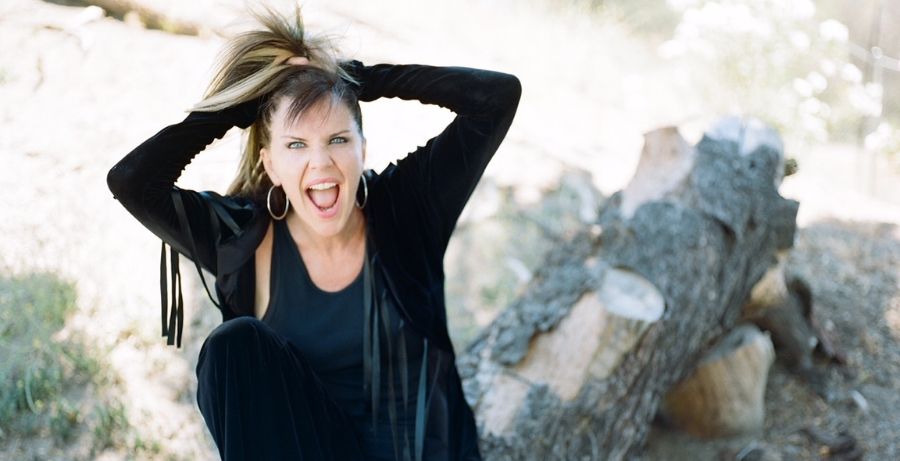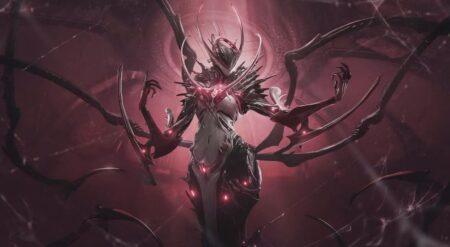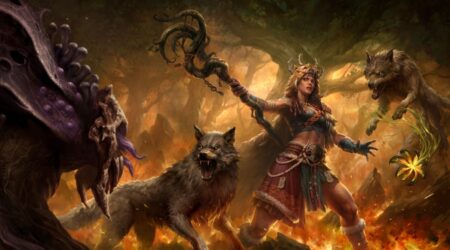Jennifer Hale is a legend, having brought to life more video game characters than any other female actor. Her credits have shaped generations of gamers and defined the games she’s worked on. Now, she’s joined the voice cast of Wayfinder as Kestrel, Airship Syndicate’s love letter to the MMO and RPG genre. At the PAX West 2023 Wayfinder event, hosted by the studio, we got the chance to talk with Jennifer Hale about her place in gaming history, the skill that goes into voice acting, and what her process behind bringing characters to life is like.
This interview has been edited for clarity and length.
BUT WHY THO: Your voice acting is extremely dynamic. You do a great job of viewing pretty much every line with emotion and really letting the players know the totality of the character in a single line, but at the same time, you don’t have access to your body. I wanted to know a little bit about the process of bringing characters to life in this way?
JENNIFER HALE: That’s really interesting, hearing you describe it that way, because I actually do use my entire body. We sort of train ourselves to keep my mouth inside this three-by-three cube that is six inches, roughly give or take, depending on the engineer. Just about six to eight inches from the mic, and my body will still move all around. Like right now I’m wearing these bracelets, but they come off [in the booth] because of how much sound they make. When you buy clothes, like fleece, the kind of stuff you’re wearing, you can totally work in that jacket but I have notes against wearing brushed cotton because I move so much. [In the booth], I really am living the life of the character.
BUT WHY THO: I guess let me rephrase a little bit. What I meant was not being able to use your own face like in on-camera acting. In live-action, you have the ability to use everything, so how do you create those pieces of characters with just your voice?
JENNIFER HALE: Yeah, it’s funny. I’ve done both for so long…and in that I know, it can be just a look, it can be just the slightest tilt of an eyebrow, or the smallest tip of the head, or just the complete stillness of your character that communicates everything. I will say, voice acting, especially in games, has evolved so much over the last decade, especially since the beginning…But for me, I need to make sure that thought registers on the mic, you know? They say thought registers on camera, and thought registers on the mic too.
If I’m actually living that experience, then you get to—as the player, as the person playing a game—too. And that’s really always my goal. I’ve been doing it long enough that I don’t really focus on how I’m doing it. Because I think that’s the depth to a good performance. I focus on what I’m doing as a character and what you know about we’re doing here, and then it falls together.

BUT WHY THO: I love hearing you talk about voice acting. It really showcases the skill that goes into acting in general, but also really brings those characters to life. How do you move between characters from such a large range of types? Can you maybe give a little bit of examples of what jumping in and out of completely different personas is like? How do you manage to and move between the worlds?
JENNIFER HALE: You know, it’s interesting. I sometimes think about it like learning to play a sport. I don’t know, like tennis or ping pong, where you got to throw the ball in the air just right and swing the racket just right and get it across the thing and keep it in the lines. And when you first start, it’s like, okay, what is step one, step two, step three, and it’s the same with acting.
At first, it’s like, “Okay, who am I? What is this person I’m playing? What are they? Who are they? What do they want? Where they want? Who were they talking to?” All of those are acting 101 questions, right? Yeah, we filtered those one by one. And I always say to actors, when you have that moment where you have that dead feeling, like you can’t connect to the material, you just forgot one of your details. Go back to checklists to describe the detail, thats all, or swap out your substitution.
But when I’m going role to role or personality to personality, at this point, that is all that little checklist, and all those little steps have become intuitive and it’s just I’m very lucky that by repetition it has become flow. That’s really the key, and there’s the formula for anybody.
BUT WHY THO: Do you have any favorite types of lines to record in the booth?
JENNIFER HALE: You know, I love a good renegade interruption. You know, just getting in your face.

BUT WHY THO: You mentioned using your body a lot when you’re working and being in games, there is a lot of action and a lot of intensity. How do you get into character to run through your Efforts? And how do you protect your voice in the more intense instances?
JENNIFER HALE: I was working on a project yesterday, and I said to the director, “These are very vocally expensive lines. I don’t want to spend all of our vocal capital right now. Because I know we have another 85 lines to do. So can we hold these?”…But there are technical things that one does, like singing training, breath support, and learning how to make those [intense] sounds as safely as possible. And then sometimes you can’t help it and you just don’t do them very often. It’s important to give yourself recovery time.
In terms of being a character during those moments, I like to have nailed down who the character is first before we do the effort sets. Because one character’s efforts are going to be completely different than other characters. A seasoned warrior, when they’re getting wounded or getting injured, there’s not always fear present. Yeah, there’s discomfort, there’s sometimes surprise, and then sometimes there is a small amount of fear. But if you’ve got a civilian character that’s getting hurt, they’re typically always focused on fear. There has to be a part of that sound to show that exact experience.
BUT WHY THO: So for the characters, when you do take them on, do you ever kind of build out more expanded stories for yourself as you live in them?
JENNIFER HALE: Oh my god! I was talking about this the other day on the site. I remember in the beginning, I would sit there and I would take my script. And I would write out the subtext. And then I would run out of script paper and then I would get a notebook. And I’d first write out the entire backstory of who the character is so that I don’t ever have to look at it again….When I write that out, I just get it in my body. Then I’d write the subtext, and then I’d write what could have been my other answers to that moment because you doubt what you’re actually going to say in real life as the character. I do play with that [specific part] a lot.
Plus, when I first started doing cartoons, I would write in those sorts of moments, and then I would go to action descriptions that cartoon scripts and animation scripts have since they have a lot of descriptions. Video game scripts are often a spreadsheet. But I would actually draw a line if there was a physical action from that action to the line that it might impact, you know, that sort of thing.
BUT WHY THO: What I love about watching voice actors grow and do their work is when they get to be specific characters across years. We watch their characters across the lifespans and it leaves an impact. As you take on roles that have that longevity, do you ever think about the impacts that they leave? Possibly on multiple generations like with Commander Shepard?

JENNIFER HALE: No. No, but just out of self-preservation? It’s so daunting to think about [that reality]. But there’s actually an acting reason for [not thinking about this]. It’s that my character is not thinking about that. I am totally like Dory from Finding Nemo. Short-term memory only…because you really do have to just totally drop into [new characters and roles]. I think my favorite thing about working are two things. Number one, I, Jennifer Hale, disappear. And number two, you’re totally living in the moment. It requires love, especially in games, and requires levels of focus that are you know, to stay in that moment like that. It’s basically a four-hour one-person show where you are recording sessions because they’re the subcontractors a four-hour session when you get a couple of quick breaks.
BUT WHY THO: I do a lot of Voice Actor interviews, and I think it’s something that I love doing because it’s a craft that is not always looked at through the full scope of what you’re doing in that booth. And so hearing you explain your process and getting to hear how you craft each character and the skills and training that go into every one of the pieces of a performance.
JENNIFER HALE: There’s an interesting thing that happens. I realized I do like flash memorization. Oh, now working, I’ll see the Excel sheet and my room, my booth, with my room full of imaginary friends. I’m talking to the people over there who were after us or that thing behind us that just happened. That room is always full. And frequently, I will see the line on the spreadsheet, and I’ll pull it out and link it to my imaginary friend in the corner to talk to them—who I always placed on the perfect side of the microphone of course. But that’s actually most often when I screw up a line because I either messed up the flash memorization or I just blanked.
BUT WHY THO: Not to make you pick a favorite but, do you maybe have a favorite type of character you like bringing to life the most?
JENNIFER HALE: Actually, the thing I love the most is the sheer variety of things I’ve had the privilege to do. That can be everything from you know Commander Shepard to Princess Morbucks, to you know, this incredible character and a series I’m not allowed to talk about but it will never see the light of day but it was an amazing series, and then in the Star Wars universe even Riyo Chuchi and all that sort of thing. Like, I just love the the varieties. Like it’s such a privilege.
And I don’t feel like I was put in a box.
And truthfully, Jennifer Hale has never been put in a box. She’s played warriors and princesses and princess warriors and every kind of human in between. An icon in games and animation, Hale’s impact comes from her immense skill and time spent honing her craft. A skill that brings out the humanity and emotion of every role, showcasing the importance of a human behind the voice at a time when SAG-AFTRA has authorized strike authorization to keep AI from replacing hard-working actors.
Hale’s legendary status and long career are inspiring, and hearing her break down the ways in which she has grown and learned from her work is something special.
Wayfinder is in early access now.







